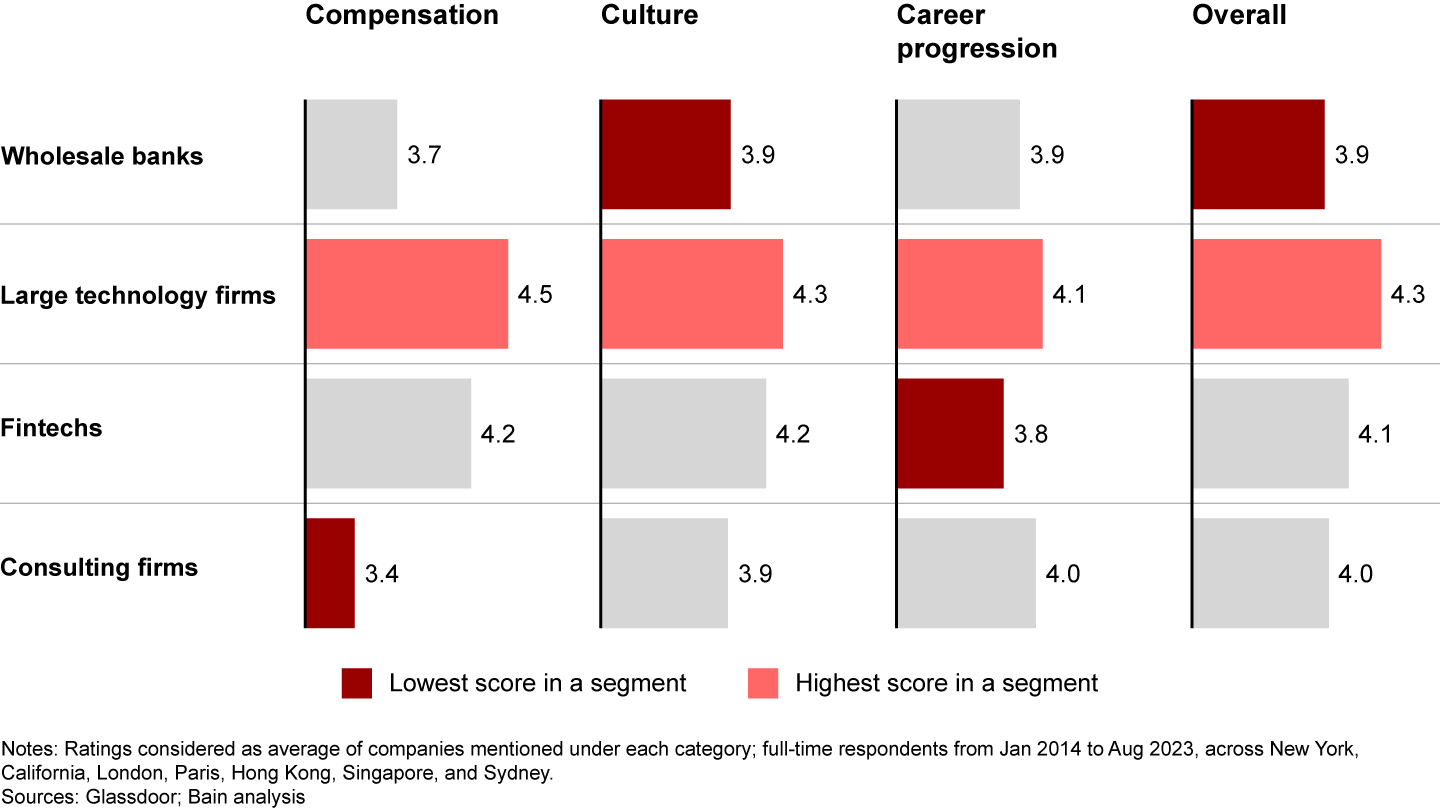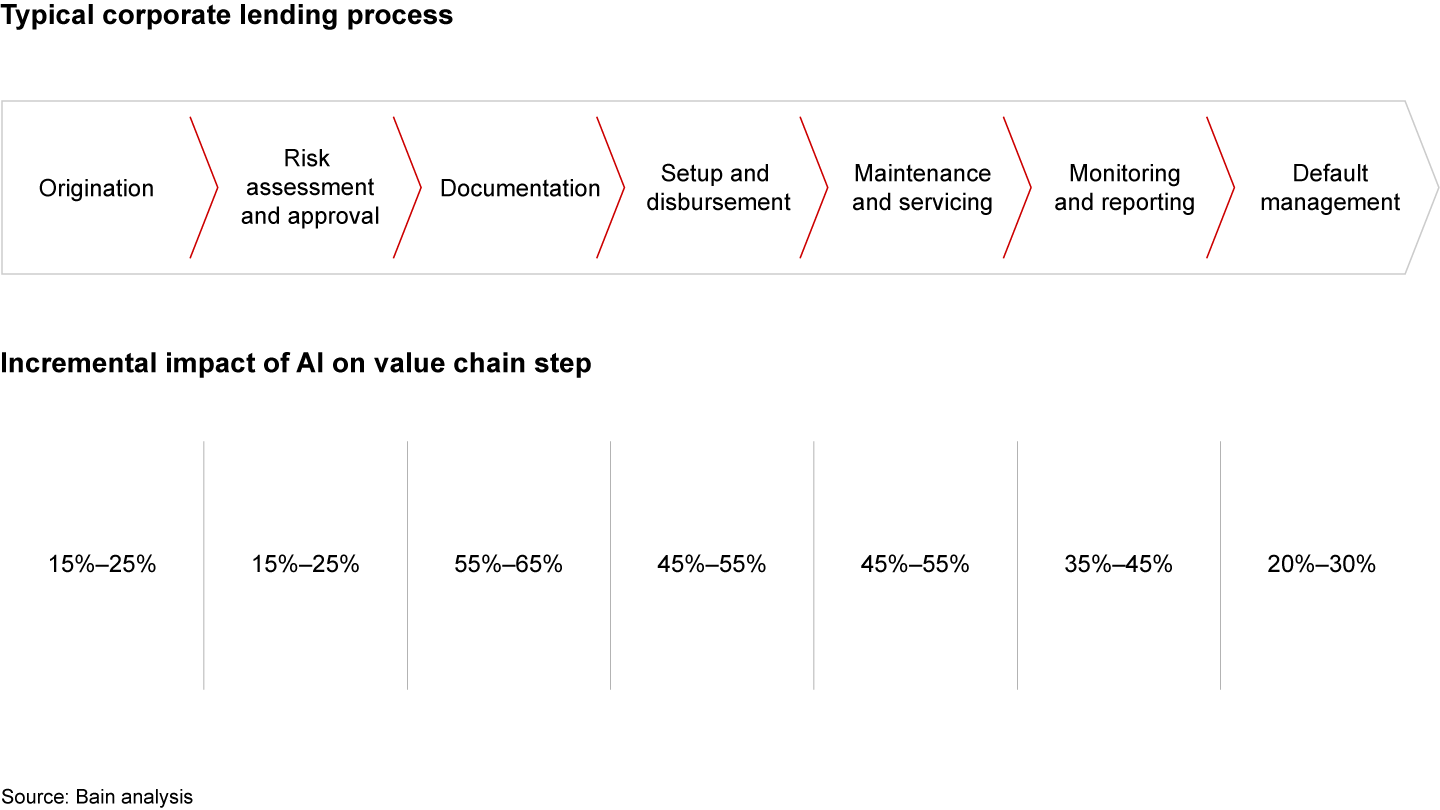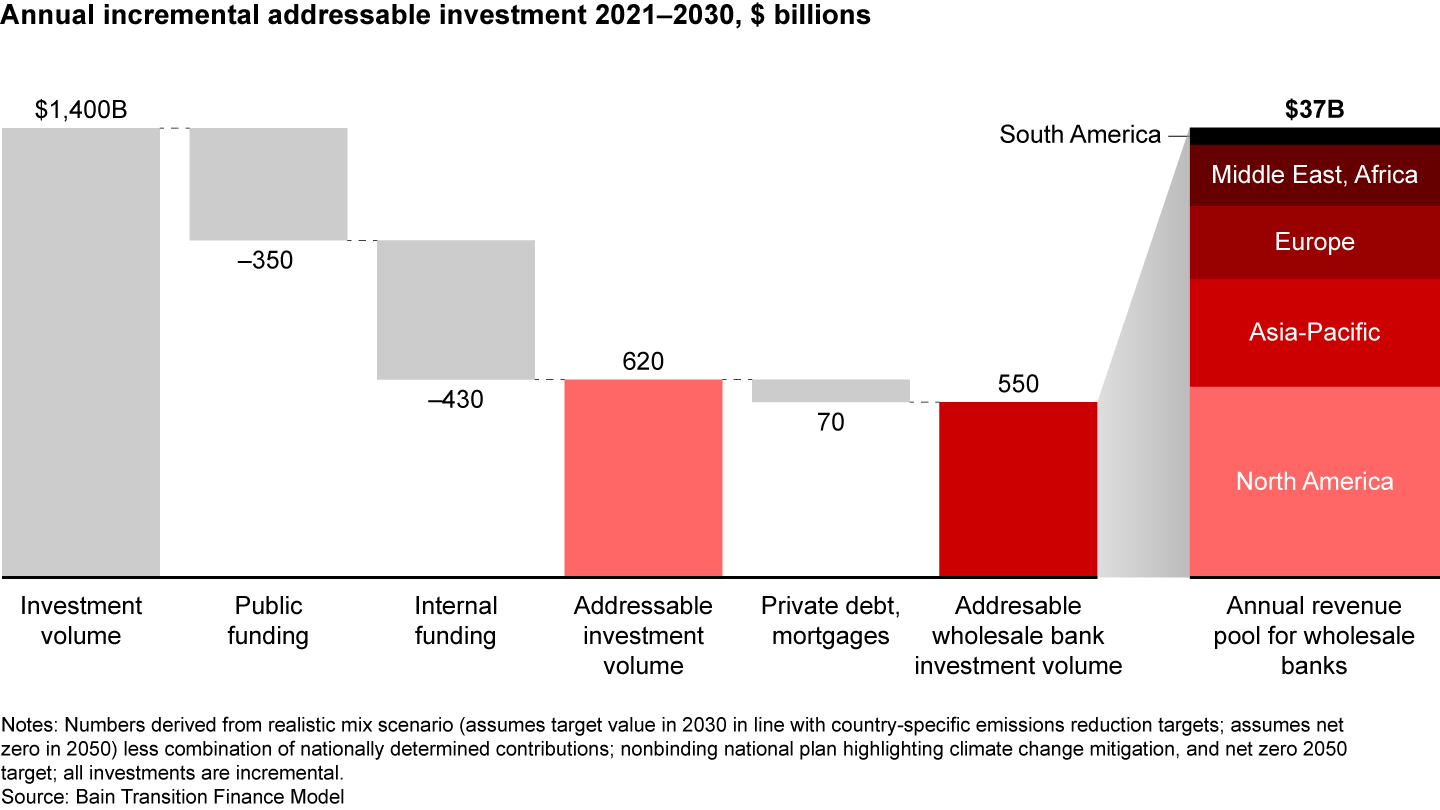Brief

Auf einen Blick
- Wholesale banks will likely face slower growth over the next few years, while heavy spending on IT puts pressure on short-term profitability.
- Our extensive interviews with wholesale banking CEOs and senior executives suggest that returning to growth will require responses to several trends affecting the industry.
- Three of the trends revolve around technology: modernizing core IT, putting generative artificial intelligence to work, and adopting digital assets.
- Another trend involves attracting and motivating employees who have different priorities than in the past. And the final trend concerns the opportunities presented by climate-related financing and carbon markets.
After a long period of macroeconomic volatility and low interest rates that eroded the economics of many wholesale banks, the industry enjoyed a resurgence in revenues, with 8% compound annual growth (CAGR) from 2019 through 2022. Corporate lending income soared as net interest margins expanded, and transaction banking volumes also gained. These businesses offset a contraction in investment banking revenues as deal volumes dropped, while capital markets flattened after Covid-induced enthusiasm waned.
During this period several global banks rebalanced their revenue streams to make their enterprise more resilient. For example, JPMorgan Chase strengthened transaction banking, and Morgan Stanley sharpened its focus on asset and wealth management, which is capital light.
Yet when we look ahead, the near-term outlook shows lower growth and a softening in many lines of business. Among the roughly 30 chief executive officers and senior executives at large wholesale banks that we recently interviewed, 52% view the industry’s condition as merely average and expect headwinds from a recessionary environment, especially in Europe. Bain & Company expects 2022–2025 wholesale bank revenue to slow to between –2% and 2% CAGR, depending on how interest rates and inflation pan out (see Figure 1).


Higher interest rates likely will dampen demand for corporate loans. In investment banking, the mergers and acquisitions pipeline is expected to remain weak due to fewer private-equity-led deals and the high cost of debt. And banks are ploughing back an average 8% to 10% of annual revenues as IT investments. All of these trends amplify the pressure on profitability.
In response to these challenges, management’s agenda will shift accordingly. Currently, the most pressing concerns among executives we interviewed are cost optimization, revenue growth, and digital investments. Over the next three to five years, we expect five themes to be the most important in reshaping the industry—themes well worth the attention of executives and boards, with a realignment of resources to address them. These themes involve modernization of the technology stack, winning the war on talent, development of analytics and AI capabilities, addressing climate financing needs, and capturing the opportunity presented by digital assets.
Let’s explore each theme in turn.
Technology desperately needs modernization
At many large banks, there is a gap between the ambition to harness data analytics and actually realizing value. Some large wholesale banks still suffer from their product-centric systems, such as being unable to create a holistic view of a client’s business across products and solutions. It’s no surprise, then, that 76% of executives we interviewed feel their technology organization does not deliver value for money.
Effectively deploying powerful technology has become critical to success. Modern technology, such as cloud-native banking platforms and processes supported by artificial intelligence (AI), can enable banks to automate sophisticated tasks and thereby provide real-time responses to customers at a lower cost.
Wholesale banks have to balance shifting investment from legacy “run the bank” operations to innovation and richer functionality, without tripping over technical debt (the accumulation of shortcuts and quick hacks to legacy systems that limit an organization’s agility and constrain innovation). Spending more on technology in itself does not lead to better performance in total shareholder return, cost-to-income ratio, or customer loyalty. In fact, IT spending relative to revenue had a negative correlation with performance, Bain analysis finds. Complexity can increase when a bank ramps up IT spending too fast, because funds may not be spent strategically, without the right oversight of architecture or as part of a coordinated modernization strategy.
Instead, modernizing technology is more about choices around architecture and governance. In our experience, an effective approach is to stage modernization by individual customer journey. Example journeys could be credit assessment and underwriting, or client origination. Modernizing by customer journey yields incremental benefits for each journey, reducing dependencies on “big bang” platform overhauls. By contrast, many banks take a “horizontal” approach that modernizes by platform—digital tools, core systems, and infrastructure—across all customer journeys. This can defer benefits, create complex interdependencies, and may not materially improve the user experience.
Employees have different priorities—less about money, more about purpose
Wholesale banks are losing their privileged position for high-potential talent, as the appeal of monetary compensation gets diluted relative to culture and career progression (see Figure 2). Many more employees and recruits want a hybrid home-and-office work model. Many more want purposeful work, replete with learning opportunities, intensive collaboration, and connections to colleagues. And more would consider switching to a company with a robust diversity strategy or greater transparency on pay equity.


Moreover, the ranks of traditional wholesale banking roles will shrink as some are digitized via automation, self-service, and data analytics. Newer digital roles will include data scientists and full-stack engineers.
Wholesale banks regaining ground will entail an overhaul of their proposition to employees, along with beefing up the analytics skill of the human resources function. Line leaders will need to take ownership of diversity practices and outcomes, embedding metrics for inclusion (such as the share of diverse candidates interviewed for every role). They will also have to learn to tap into hidden pools of talent by searching outside financial services in technology and other regulated industries.
Generative AI will fundamentally change the business and operating model—if banks rise to the implementation challenge
In our interviews, 72% of executives expect generative AI to transform how they do business on several dimensions:
- in developing insights for corporate clients around topics such as liquidity optimization;
- optimizing core processes, such as automating steps of the lending process (see Figure 3);
- enabling front-line employees with customized transaction reports, or immediately answering direct client queries;
- analyzing news sentiment to better forecast the financial consequences of market positions; and
- managing regulatory demands to promptly identify and actively manage the consequences of new regulations.


Despite these high expectations, only 24% of the executives believe their organizations are geared to unlock AI’s potential. The reasons are varied, including a shortage of AI talent, risks in accuracy, data privacy, and cybersecurity, and lack of clarity about which initiatives deserve the highest priority for investment.
If wholesale banks are to harness AI, executives should choose priority areas, balancing value with complexity, reusability, and associated risk. They will need to build capabilities to scale up the AI program, with staffing in multiple departments and extensive training and skills upgrading. With those capabilities in place, wholesale banks can accelerate the time to reap value through early deployments of use cases, seeking good enough rather than perfect outcomes.
Climate-related financing and carbon markets present major opportunities
We estimate that climate-related products and services will offer $1.4 trillion in annual incremental financing globally through 2030, of which $550 billion will be addressable by wholesale banks. This could generate a $37 billion annual revenue pool, 80% of which would flow from corporate lending (see Figure 4). Carbon credits represent an additional revenue opportunity.


Some 57% of executives interviewed feel their banks are advanced on the climate agenda. However, this budding market is not straightforward to operationalize. Many of them perceive it will be highly complex for bank and client alike. Some organizations have not wholeheartedly bought into the case for change. And others are concerned that the reporting and underlying data will be hard to obtain.
To optimize the portfolio requires advances on several fronts. Wholesale banks will want to educate and support clients in their bid to make operations more sustainable. They can incorporate sustainability covenants into lending contracts. For those clients unable or unwilling to make improvements, banks should limit their exposure.
In terms of banks’ own operations, they should allocate targets for specific business portfolios. Internal steering should rely on key performance indicators tailored to each core activity of the bank, which will unlock climate insights and ensure consistency with strategic business planning, pushing for considerations beyond the traditional three-year horizon. And a full suite of climate-related products will likely depend, at least in the short term, on the help of external partners such as transition risk and physical-risk data providers and, in many places, external regulatory reporting solutions.
Digital assets should make many activities more efficient
Blockchain market infrastructure and the use of tokenization could transform private assets, such as PE funds, private debt, and real estate, by introducing more liquidity, transparency, and automated settlement. Digital currencies could speed up cross-border money movement and clearing and settlements, with better security and potentially much lower costs. And the use of distributed ledger technology may finally make it possible to eliminate repetitive know-your-customer due diligence.
Digital assets and blockchain capabilities could result in lower cost structures in sell-side and buy-side businesses (see Figure 5).


However, only 48% of the executives interviewed are active in digital assets today. Many of them are concerned about an unclear investment case, a long payback period, and regulatory uncertainty around digital assets. They also anticipate big challenges in creating a new ecosystem.
To overcome these concerns, it will be critical to pursue an approach that sets goals for each division of the whole bank while aligning with group-wide guiding principles. To get started, many banks are identifying use cases specific to a customer segment, then through selective partnerships, assembling the right mix of internal and external capabilities to deliver proof points with near-term value while getting essential experience with digital assets.
* * *
The macro boom times are over. Achieving further growth will be more difficult but achievable for those wholesale banks that commit sufficient resources and make smart choices around technology, talent, and products that resonate in climate- and carbon-related markets.